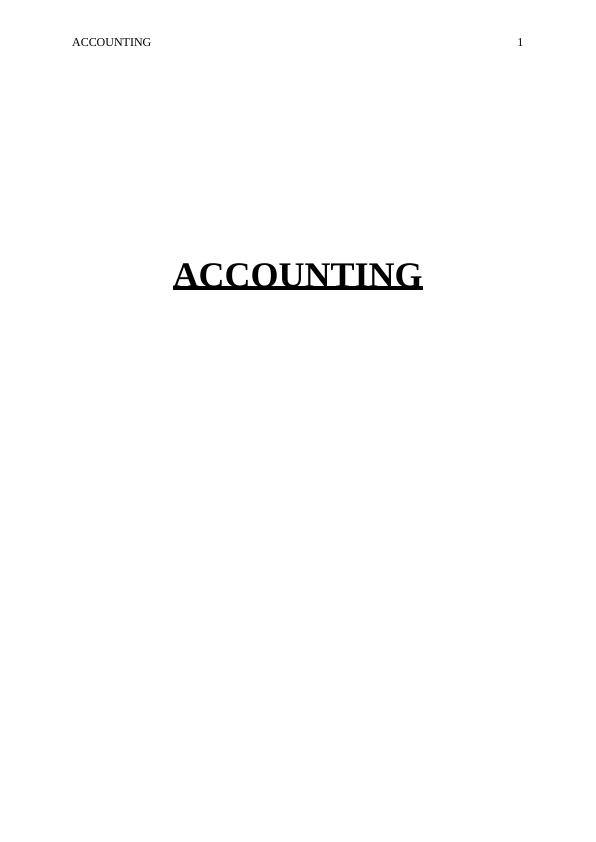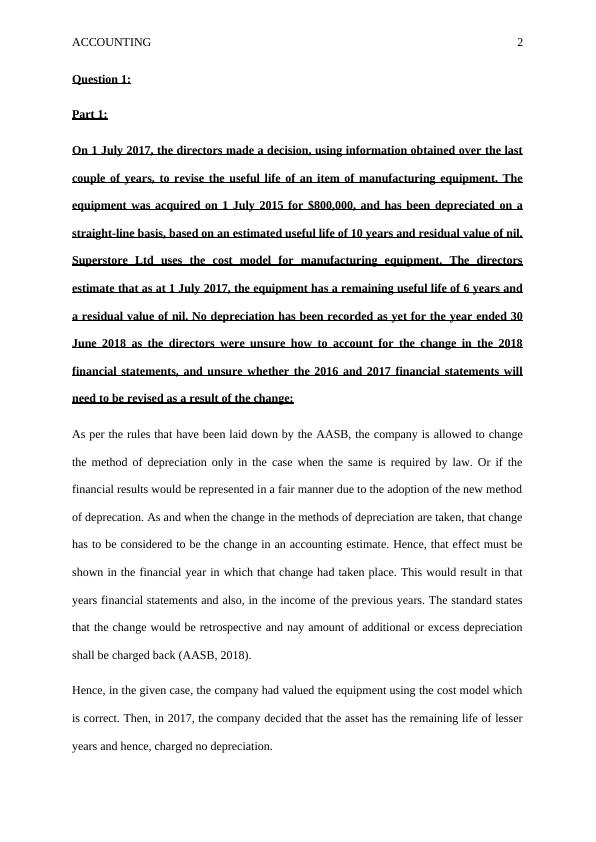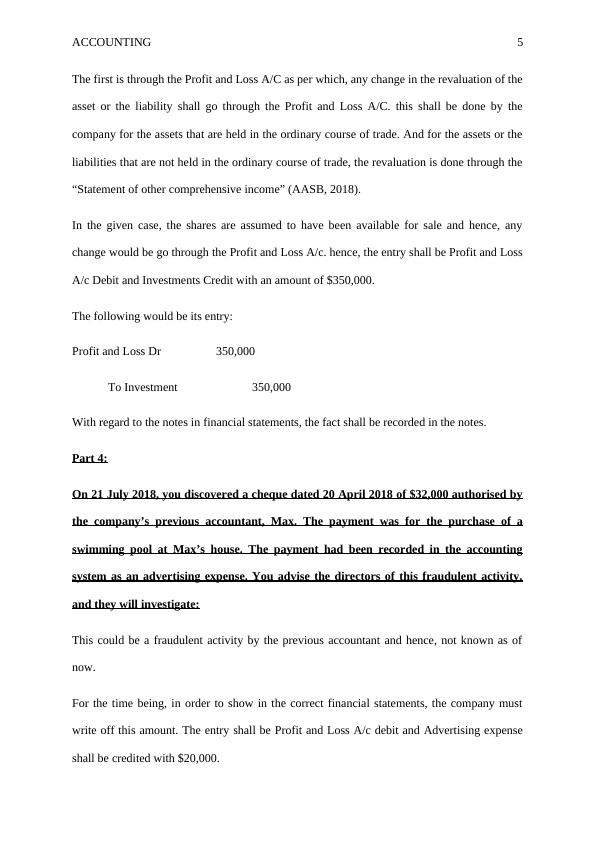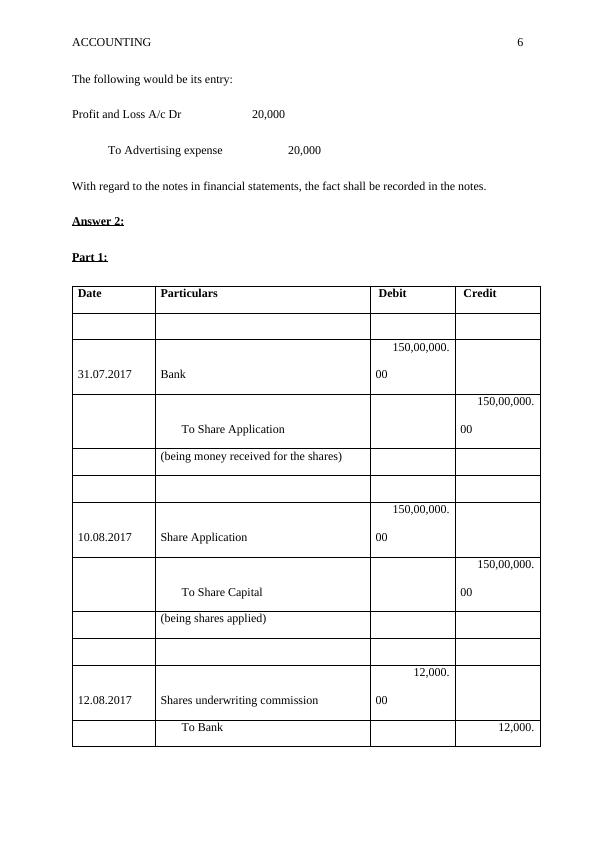Accounting: Depreciation, Repairs, Shares and Taxable Income
Added on 2023-06-08
23 Pages2540 Words398 Views
ACCOUNTING 1
ACCOUNTING
ACCOUNTING

ACCOUNTING 2
Question 1:
Part 1:
On 1 July 2017, the directors made a decision, using information obtained over the last
couple of years, to revise the useful life of an item of manufacturing equipment. The
equipment was acquired on 1 July 2015 for $800,000, and has been depreciated on a
straight-line basis, based on an estimated useful life of 10 years and residual value of nil.
Superstore Ltd uses the cost model for manufacturing equipment. The directors
estimate that as at 1 July 2017, the equipment has a remaining useful life of 6 years and
a residual value of nil. No depreciation has been recorded as yet for the year ended 30
June 2018 as the directors were unsure how to account for the change in the 2018
financial statements, and unsure whether the 2016 and 2017 financial statements will
need to be revised as a result of the change:
As per the rules that have been laid down by the AASB, the company is allowed to change
the method of depreciation only in the case when the same is required by law. Or if the
financial results would be represented in a fair manner due to the adoption of the new method
of deprecation. As and when the change in the methods of depreciation are taken, that change
has to be considered to be the change in an accounting estimate. Hence, that effect must be
shown in the financial year in which that change had taken place. This would result in that
years financial statements and also, in the income of the previous years. The standard states
that the change would be retrospective and nay amount of additional or excess depreciation
shall be charged back (AASB, 2018).
Hence, in the given case, the company had valued the equipment using the cost model which
is correct. Then, in 2017, the company decided that the asset has the remaining life of lesser
years and hence, charged no depreciation.
Question 1:
Part 1:
On 1 July 2017, the directors made a decision, using information obtained over the last
couple of years, to revise the useful life of an item of manufacturing equipment. The
equipment was acquired on 1 July 2015 for $800,000, and has been depreciated on a
straight-line basis, based on an estimated useful life of 10 years and residual value of nil.
Superstore Ltd uses the cost model for manufacturing equipment. The directors
estimate that as at 1 July 2017, the equipment has a remaining useful life of 6 years and
a residual value of nil. No depreciation has been recorded as yet for the year ended 30
June 2018 as the directors were unsure how to account for the change in the 2018
financial statements, and unsure whether the 2016 and 2017 financial statements will
need to be revised as a result of the change:
As per the rules that have been laid down by the AASB, the company is allowed to change
the method of depreciation only in the case when the same is required by law. Or if the
financial results would be represented in a fair manner due to the adoption of the new method
of deprecation. As and when the change in the methods of depreciation are taken, that change
has to be considered to be the change in an accounting estimate. Hence, that effect must be
shown in the financial year in which that change had taken place. This would result in that
years financial statements and also, in the income of the previous years. The standard states
that the change would be retrospective and nay amount of additional or excess depreciation
shall be charged back (AASB, 2018).
Hence, in the given case, the company had valued the equipment using the cost model which
is correct. Then, in 2017, the company decided that the asset has the remaining life of lesser
years and hence, charged no depreciation.

ACCOUNTING 3
The correct accounting treatment of this entry should have been that the company should
have charged the depreciation since year ended 2018 at $(800000-160000-0)/6=$106,667
which is the original cost of asset-depreciation charged till date (80000*2)-salvage value in
2018 divided by the number of useful lives.
Since, the company has not charged in the depreciation till now, it shall now charge it at the
above stated amount.
The following would be its entry:
Depreciation expense Dr 106,667
To Accumulated depreciation 106,667
With regard to the notes in financial statements, the fact shall be recorded in the notes.
Part 2:
In June 2018, the accounts payable officer discovered that an invoice for repairs to
equipment, with an amount due of $20,000, incurred in June 2017, had not been paid or
provided for in the 2017 financial statements. The invoice was paid on 12 July 2018. The
repairs are deductible for tax purposes. The accountant responsible for preparing the
company’s income tax returns will amend the 2017 tax return, and the company will
receive a tax refund of $6,000 as a result (30% x $20,000). No journal entries have been
done as yet in the accounting records of Superstore Ltd, as the directors are unsure how
to account for this situation, and what period adjustments need to be made in:
In June 2018, the accounts payable officer discovered that an invoice for repairs to
equipment, with an amount due of $20,000, incurred in June 2017, had not been paid or
provided for in the 2017 financial statements. The invoice was paid on 12 July 2018. The
repairs are deductible for tax purposes. The accountant responsible for preparing the
The correct accounting treatment of this entry should have been that the company should
have charged the depreciation since year ended 2018 at $(800000-160000-0)/6=$106,667
which is the original cost of asset-depreciation charged till date (80000*2)-salvage value in
2018 divided by the number of useful lives.
Since, the company has not charged in the depreciation till now, it shall now charge it at the
above stated amount.
The following would be its entry:
Depreciation expense Dr 106,667
To Accumulated depreciation 106,667
With regard to the notes in financial statements, the fact shall be recorded in the notes.
Part 2:
In June 2018, the accounts payable officer discovered that an invoice for repairs to
equipment, with an amount due of $20,000, incurred in June 2017, had not been paid or
provided for in the 2017 financial statements. The invoice was paid on 12 July 2018. The
repairs are deductible for tax purposes. The accountant responsible for preparing the
company’s income tax returns will amend the 2017 tax return, and the company will
receive a tax refund of $6,000 as a result (30% x $20,000). No journal entries have been
done as yet in the accounting records of Superstore Ltd, as the directors are unsure how
to account for this situation, and what period adjustments need to be made in:
In June 2018, the accounts payable officer discovered that an invoice for repairs to
equipment, with an amount due of $20,000, incurred in June 2017, had not been paid or
provided for in the 2017 financial statements. The invoice was paid on 12 July 2018. The
repairs are deductible for tax purposes. The accountant responsible for preparing the

ACCOUNTING 4
company’s income tax returns will amend the 2017 tax return, and the company will receive a
tax refund of $6,000 as a result (30% x $20,000). No journal entries have been done as yet in
the accounting records of Superstore Ltd, as the directors are unsure how to account for this
situation, and what period adjustments need to be made in.
The AASB states the fact that any amount which has not been recognised as either costs or
revenue and though should have, should have shown as the revenue or loss from the prior
period.
Hence, in the given case too, the company shall record in the expense of $20,000 in the books
of accounts of the year ended 2018 (EY, 2018).
The following would be its entry:
Repairs on equipment expense Dr 20,000
To Profit and Loss A/c 20,000
With regard to the notes in financial statements, the fact shall not be recorded in the notes.
Part 3:
Superstore Ltd holds shares in a listed public company, ABC Ltd, which are valued in
the draft financial statements on 30 June 2018 at their market value on that date -
$600,000. A major fall in the stock market occurred on 10 July 2018, and the value of
Superstore’s shares in ABC Ltd declined to $250,000:
AASB 13 states that any asset or the liability that is held by the company shall be reported at
its fair value. The fair value has been defined as the amount that any asset would fetch when
sold in the open market. The standard further states 2 types of accounting of these sorts of
assets.
company’s income tax returns will amend the 2017 tax return, and the company will receive a
tax refund of $6,000 as a result (30% x $20,000). No journal entries have been done as yet in
the accounting records of Superstore Ltd, as the directors are unsure how to account for this
situation, and what period adjustments need to be made in.
The AASB states the fact that any amount which has not been recognised as either costs or
revenue and though should have, should have shown as the revenue or loss from the prior
period.
Hence, in the given case too, the company shall record in the expense of $20,000 in the books
of accounts of the year ended 2018 (EY, 2018).
The following would be its entry:
Repairs on equipment expense Dr 20,000
To Profit and Loss A/c 20,000
With regard to the notes in financial statements, the fact shall not be recorded in the notes.
Part 3:
Superstore Ltd holds shares in a listed public company, ABC Ltd, which are valued in
the draft financial statements on 30 June 2018 at their market value on that date -
$600,000. A major fall in the stock market occurred on 10 July 2018, and the value of
Superstore’s shares in ABC Ltd declined to $250,000:
AASB 13 states that any asset or the liability that is held by the company shall be reported at
its fair value. The fair value has been defined as the amount that any asset would fetch when
sold in the open market. The standard further states 2 types of accounting of these sorts of
assets.

ACCOUNTING 5
The first is through the Profit and Loss A/C as per which, any change in the revaluation of the
asset or the liability shall go through the Profit and Loss A/C. this shall be done by the
company for the assets that are held in the ordinary course of trade. And for the assets or the
liabilities that are not held in the ordinary course of trade, the revaluation is done through the
“Statement of other comprehensive income” (AASB, 2018).
In the given case, the shares are assumed to have been available for sale and hence, any
change would be go through the Profit and Loss A/c. hence, the entry shall be Profit and Loss
A/c Debit and Investments Credit with an amount of $350,000.
The following would be its entry:
Profit and Loss Dr 350,000
To Investment 350,000
With regard to the notes in financial statements, the fact shall be recorded in the notes.
Part 4:
On 21 July 2018, you discovered a cheque dated 20 April 2018 of $32,000 authorised by
the company’s previous accountant, Max. The payment was for the purchase of a
swimming pool at Max’s house. The payment had been recorded in the accounting
system as an advertising expense. You advise the directors of this fraudulent activity,
and they will investigate:
This could be a fraudulent activity by the previous accountant and hence, not known as of
now.
For the time being, in order to show in the correct financial statements, the company must
write off this amount. The entry shall be Profit and Loss A/c debit and Advertising expense
shall be credited with $20,000.
The first is through the Profit and Loss A/C as per which, any change in the revaluation of the
asset or the liability shall go through the Profit and Loss A/C. this shall be done by the
company for the assets that are held in the ordinary course of trade. And for the assets or the
liabilities that are not held in the ordinary course of trade, the revaluation is done through the
“Statement of other comprehensive income” (AASB, 2018).
In the given case, the shares are assumed to have been available for sale and hence, any
change would be go through the Profit and Loss A/c. hence, the entry shall be Profit and Loss
A/c Debit and Investments Credit with an amount of $350,000.
The following would be its entry:
Profit and Loss Dr 350,000
To Investment 350,000
With regard to the notes in financial statements, the fact shall be recorded in the notes.
Part 4:
On 21 July 2018, you discovered a cheque dated 20 April 2018 of $32,000 authorised by
the company’s previous accountant, Max. The payment was for the purchase of a
swimming pool at Max’s house. The payment had been recorded in the accounting
system as an advertising expense. You advise the directors of this fraudulent activity,
and they will investigate:
This could be a fraudulent activity by the previous accountant and hence, not known as of
now.
For the time being, in order to show in the correct financial statements, the company must
write off this amount. The entry shall be Profit and Loss A/c debit and Advertising expense
shall be credited with $20,000.

ACCOUNTING 6
The following would be its entry:
Profit and Loss A/c Dr 20,000
To Advertising expense 20,000
With regard to the notes in financial statements, the fact shall be recorded in the notes.
Answer 2:
Part 1:
Date Particulars Debit Credit
31.07.2017 Bank
150,00,000.
00
To Share Application
150,00,000.
00
(being money received for the shares)
10.08.2017 Share Application
150,00,000.
00
To Share Capital
150,00,000.
00
(being shares applied)
12.08.2017 Shares underwriting commission
12,000.
00
To Bank 12,000.
The following would be its entry:
Profit and Loss A/c Dr 20,000
To Advertising expense 20,000
With regard to the notes in financial statements, the fact shall be recorded in the notes.
Answer 2:
Part 1:
Date Particulars Debit Credit
31.07.2017 Bank
150,00,000.
00
To Share Application
150,00,000.
00
(being money received for the shares)
10.08.2017 Share Application
150,00,000.
00
To Share Capital
150,00,000.
00
(being shares applied)
12.08.2017 Shares underwriting commission
12,000.
00
To Bank 12,000.

End of preview
Want to access all the pages? Upload your documents or become a member.
Related Documents
Financial Accounting Solutions for Disclosure, Shares, Taxes, Revaluation and Impairmentlg...
|13
|2305
|87
Financial Accounting: Financial Statement Disclosures, Share Capital, Income Tax, Revaluation of Property, Plant and Equipment, Impairment of Assetslg...
|13
|882
|208
Financial Accounting: Financial Statement Disclosures, Share Capital, Income Tax, Revaluation of Property, Plant and Equipment, Impairment of Assetslg...
|13
|893
|106
Financial Accounting: Accounting Policies, Changes in Accounting Estimates and Errorslg...
|25
|2479
|273
Accounting Treatment for Various Situations - Deskliblg...
|12
|2263
|333
Advance Financial Accounting: Case Study Analysis and Solutionslg...
|15
|2527
|144